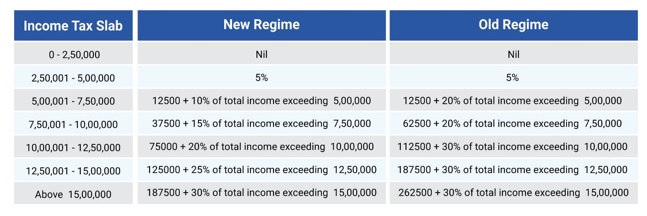
With every budget, most people, especially salaried individuals, expect a reduction in the direct tax rates, a positive change in tax slabs, or some sort of rebate. Sometimes their expectations are met and sometimes they are not. These expectations are largely driven by a desire to reduce the overall tax outgo and thereby, increase the income in hand. Even if your expectations in this regard are not met, you can still easily limit your tax outgo through judicious tax planning. As you prioritise tax planning, here is a look at the current regime, the previous one, and how you can save taxes.
Income Tax Slabs and Rates
The previous Union Budget, unveiled in February 2020, revamped the income tax slabs to offer relief to tax-payers, proposing a marked alteration over the tax rates being levied earlier.

While the previous tax regime slab rates were differentiated based on age group, the new regime does not prescribe to the same pattern. Additionally, the new tax regime does not allow you to claim any exemptions that were eligible as per the old tax regime. It is imperative that you consider the nuances of both tax regimes, along with your requirements, before deciding on the best option for you.
Mutual funds can help save taxes
Once you decide on the best tax regime for your individual requirements, it is time to consider tax-saving options to limit your income outflow. A savvy financial plan will consider the various tax saving instruments available, including Public Provident Fund (PPF), National Pension System (NPS), Equity-Linked Savings Schemes (ELSS), fixed deposits (FDs), life insurance, health insurance, etc. One of the most preferred methods of saving tax is investing in a mutual fund scheme, like ELSS, which offers you the potential for returns along with a tax saving opportunity.
Limiting tax outflow through the ELSS mutual fund route
Investors and financial planners prefer saving tax via ELSS investments because this is, usually, the most lucrative option, considering the short lock-in periods (three years), as well as the possibility of better returns, when compared to other instruments like PPF and NPS. Additionally, the earnings and maturity proceeds on such funds are tax exempt, as long as you adhere to the lock-in period of the scheme, making this option even more attractive to potential investors. ELSS funds qualify for a tax deduction of up to 1.5 lakh rupees, helping you create and secure wealth for the long term, in a decidedly hassle-free manner. You can invest your hard-earned money in such funds in a systematic and phased out manner, through SIPs, or even as a lump sum investment, based on your preference.
Investing in an ELSS fund is quite easy. Once you determine your income tax slab and deductible income, you can choose the best ELSS fund option by considering variables like past performance, age of the fund, and the internal rate of return on scheduled cash flows. Now that you have the fund in mind, you can easily invest online by creating an account, filling in the online form, adding bank details and a cancelled cheque, and choosing the investment option (either SIP or lump sum).
You can now breathe easy and relax as your income is invested in a tax-saving mechanism that allows you to create more wealth even as you limit your tax liability.
An investor education initiative
All Mutual Fund Investors have to go through a onetime KYC process. Investor should deal only with Registered Mutual Fund (RMF). For more info on KYC, RMF and procedure to lodge/redress any complaints – please visit on https://www.edelweissmf.com/kyc-norms
MUTUAL FUND INVESTMENTS ARE SUBJECT TO MARKET RISKS, READ ALL SCHEME RELATED DOCUMENTS CAREFULLY.
Trending Articles
MUTUAL FUND INVESTMENTS ARE SUBJECT TO MARKET RISKS, READ ALL SCHEME RELATED DOCUMENTS CAREFULLY.















